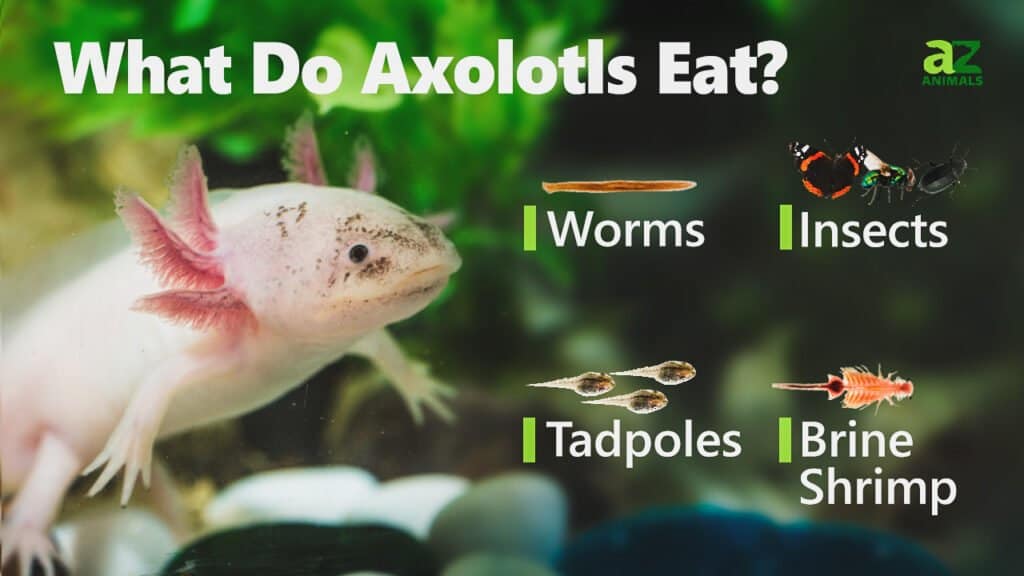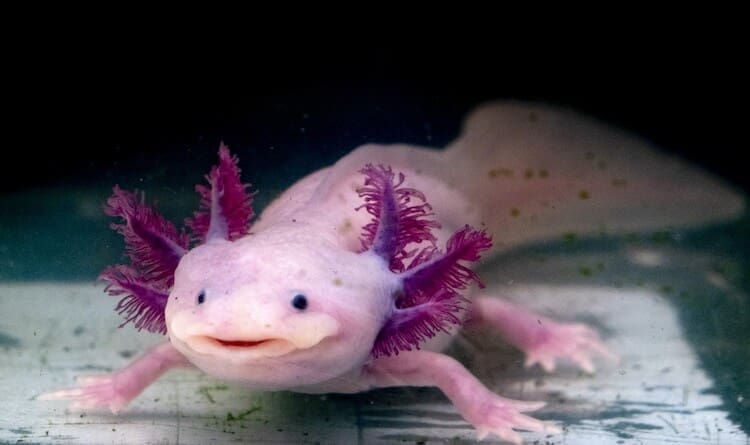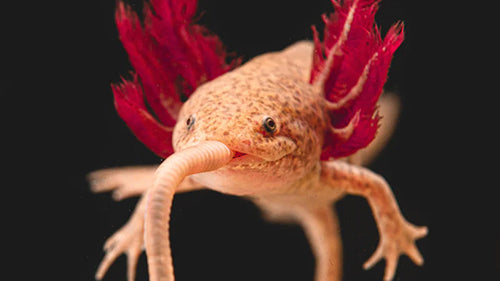Have you ever wondered what is an axolotls diet to keep them healthy and vibrant? Understanding it is crucial for any owner or enthusiast to ensure these fascinating creatures thrive.
Axolotls, often dubbed the “Mexican walking fish,” are not just any ordinary pet. They have specific dietary needs that can impact their growth, appearance, and well-being. Imagine being able to provide the perfect meal plan, ensuring your axolotl thrives while watching them flourish with vitality.
By diving into the specifics of an axolotl’s diet, you can unlock the secrets to keeping your aquatic friend happy and healthy. Stick around to discover everything you need to know about feeding your axolotl the right way!

Credit: a-z-animals.com
Natural Habitat And Feeding
Axolotls thrive in freshwater environments like lakes and canals. Their diet includes worms, small fish, and insects. These amphibians use their keen sense of smell to hunt. They are carnivorous and rely on live prey to meet their nutritional needs.
Understanding the natural habitat and feeding habits of axolotls is crucial for anyone considering these fascinating creatures as pets. Axolotls, often called “Mexican walking fish,” are actually a type of salamander. They are unique because they remain in their larval stage throughout their lives. This characteristic influences their diet and habitat needs. Let’s dive into what makes their natural environment and feeding regimen so special.
Natural Habitat
Axolotls originate from the lake complex of Xochimilco in Mexico. These lakes and canals offer a unique environment with cool, still water and plenty of hiding spots. In this habitat, axolotls are surrounded by aquatic plants, rocks, and mud, which provide both shelter and hunting grounds. They thrive in water temperatures ranging from 60-64°F (16-18°C). You might wonder how this translates to a home aquarium. Replicating this environment as closely as possible is key to their health and happiness.
Feeding In The Wild
In their natural setting, axolotls are opportunistic feeders. They consume a variety of prey, such as small fish, insects, and worms. Their diet is primarily carnivorous, relying on live food that they can catch and devour with ease. Their keen sense of smell and sight helps them locate food in the murky waters. When planning your axolotl’s diet at home, it’s important to consider what they would naturally eat. Are you providing a varied enough diet to keep them healthy?
Replicating Their Diet At Home
Feeding axolotls in captivity requires some creativity to mimic their natural diet. Consider offering live or frozen bloodworms, brine shrimp, and small fish. Pellets designed for carnivorous fish can also be a good staple, but they should not be the only food source. Variety ensures a balanced diet, much like in their wild habitat. Have you ever noticed how your axolotl responds to different foods? Observing their preferences can guide you in creating a meal plan that keeps them active and healthy.
Feeding Tips And Tricks
Axolotls eat by sucking in water and their prey along with it. So, offer food in bite-sized pieces to prevent choking. Feed them once every two to three days, adjusting based on their size and appetite. Overfeeding can lead to obesity, a common issue in captive axolotls. Watching them eat is an engaging experience. It also provides insight into their well-being. Are they eagerly chasing food, or do they seem disinterested? This could indicate a need to tweak their feeding routine. Engage with your axolotl’s needs, and you’ll ensure they thrive in your care. What steps will you take today to better replicate their wild diet?
Dietary Needs
Axolotls thrive on a diet rich in protein. These aquatic creatures enjoy worms, small fish, and insects. Feeding them a balanced diet ensures their health and longevity.
When it comes to understanding the dietary needs of axolotls, it is crucial to realize that their diet plays a significant role in their overall health and growth. Axolotls are aquatic creatures with unique dietary requirements that need careful attention. If you’re considering having an axolotl as a pet, or if you already have one, knowing what to feed them can make all the difference in their well-being.
Protein Sources
Protein is a vital component of an axolotl’s diet. These creatures are carnivorous and require a diet rich in protein to thrive. Common protein sources include earthworms, bloodworms, and brine shrimp. You might be surprised to learn that some axolotl owners even feed their pets small fish like guppies. The key is ensuring the protein is fresh and suitable for aquatic life. Have you ever thought about the protein content in what you’re feeding your axolotl?
Vitamins And Minerals
Vitamins and minerals are essential for maintaining a healthy axolotl. Calcium is particularly important, as it supports bone development and helps prevent metabolic bone disease. Offering a variety of foods can ensure a well-rounded intake of nutrients. While commercial pellets designed for axolotls are available, you can also dust live foods with a calcium supplement. Have you checked if your axolotl’s diet is meeting their nutritional needs? Remember, a balanced diet is more than just feeding the right food; it’s about understanding what your axolotl needs to stay healthy and happy. By focusing on these dietary aspects, you’re taking a proactive step towards being a responsible axolotl owner.
Feeding Techniques
Axolotls thrive on a varied diet of worms, small fish, and specially formulated pellets. These amphibians benefit from live or frozen food, ensuring a balanced intake of proteins and nutrients. Regular feeding helps maintain their health and vibrant colors.
Feeding Techniques for Axolotls Feeding your axolotl can be an enjoyable experience, both for you and your aquatic friend. Understanding the best feeding techniques can help keep your axolotl healthy and happy. Let’s dive into some practical approaches to feed your axolotl effectively.
Live Food Options
Live food can make feeding time exciting and stimulating for your axolotl. They are natural hunters, and live food offers a chance to exhibit this instinct. Consider feeding them live earthworms, which are rich in nutrients and easy for axolotls to consume. Another option is brine shrimp, especially for younger axolotls. They are small and easy to digest, making them a perfect meal. You can also try offering daphnia, which are small aquatic crustaceans that axolotls find irresistible.
Prepared Food Choices
If you’re looking for convenience, prepared food choices might be the way to go. Pellets designed specifically for axolotls are available and provide a balanced diet. They are easy to store and measure, ensuring your pet gets the right amount of nutrients. Frozen bloodworms are another excellent option. They are nutrient-rich and can be thawed and fed to your axolotl quickly. You might also want to explore specially formulated axolotl sticks, which offer a complete meal solution. Feeding your axolotl doesn’t have to be complicated. By selecting the right feeding techniques and food options, you can ensure your axolotl thrives. How do you decide what’s best for your pet? Consider their age, size, and activity level, and experiment to see which foods they prefer. This hands-on approach will help you bond with your axolotl while keeping them healthy.

Credit: www.cbreptile.com
Frequency And Portion Control
Understanding the dietary needs of axolotls is crucial for their health. These amphibians have unique feeding habits. Knowing how often and how much to feed them helps in their care. Overfeeding can lead to obesity and health issues. Underfeeding can cause malnutrition and stress. It’s important to find a balance in their diet.
Feeding Frequency
Juvenile axolotls need food every day. They are growing and need nutrients. Adult axolotls can be fed less frequently. Feeding them two to three times a week is enough. Consistent feeding schedules help maintain their health.
Portion Control
Proper portion sizes are vital for axolotls. Feed juveniles as much as they can eat in 10-15 minutes. For adults, adjust the portion size accordingly. Large meals can cause digestion problems. Smaller, more frequent meals are better.
Signs Of Overfeeding
Watch for signs of overfeeding. A bloated axolotl may be overfed. Uneaten food in the tank is another sign. Remove uneaten food to keep the tank clean. Adjust portion sizes if overfeeding is suspected.
Signs Of Underfeeding
Axolotls should not appear thin or lethargic. These are signs of underfeeding. Ensure they receive enough nutrition. Monitor their weight and adjust feeding as needed.
Common Dietary Mistakes
Axolotls thrive on a balanced diet of protein-rich foods. A common mistake is offering them too much dry food. Fresh worms and small fish should be staples to ensure their health.
Feeding your axolotl might seem straightforward, but common dietary mistakes can have serious consequences for these unique creatures. As a responsible pet owner, ensuring your axolotl’s diet is balanced and appropriate is crucial. Overfeeding, offering the wrong types of food, or neglecting nutritional requirements can lead to health problems.
Understanding Portion Size
Axolotls have a tendency to eat more than they should if given the chance. It’s easy to overestimate how much they need. You might think a little extra won’t hurt, but overfeeding can lead to obesity and related health issues. Consider the size of your axolotl when determining portion sizes. A general rule is to provide food that is about as long as the width of your axolotl’s head.
Avoiding High-fat Foods
While axolotls can technically consume various foods, not all are suitable for regular feeding. High-fat foods such as certain types of fish or fatty meats can cause long-term health issues. Providing a diet rich in lean proteins like earthworms or specially formulated pellets is a healthier choice. Regularly feeding fatty foods can lead to liver problems.
Supplementing With Live Food
Live food like brine shrimp or small fish can be an exciting treat for your axolotl. However, relying solely on live food can be problematic. It might not provide a balanced diet and can introduce parasites into your tank. Consider using live food as an occasional supplement rather than a staple. Would you want to risk your axolotl’s health by not diversifying their diet?
Providing Variety
Axolotls, like humans, benefit from a varied diet. Sticking to one type of food can lead to nutrient deficiencies over time. A mix of worms, pellets, and occasional live treats ensures they get all the nutrients they need. Experiment with different foods to see what your axolotl enjoys most. How would you feel eating the same thing every day?
Ignoring Water Quality
The food you provide affects not only your axolotl but also the water quality in their tank. Excess food can decay and cause water quality issues, leading to stress and illness. Always remove uneaten food promptly to maintain a clean environment. Is your axolotl’s tank as pristine as it should be? By paying attention to these common dietary mistakes, you can help ensure your axolotl thrives. Remember, a little bit of knowledge can go a long way in keeping your pet healthy and happy.

Credit: tropiczoneproducts.com
Adapting Diet Over Time
Axolotls are fascinating creatures with unique dietary needs. As they grow, their diet changes significantly. It is essential to understand these changes to ensure their health. Proper nutrition supports their growth and development.
Juvenile Nutrition
Young axolotls require small, protein-rich foods. They need nutrients for rapid growth. Bloodworms and brine shrimp are excellent choices. These foods are easy to digest. Ensure the diet is varied for balanced nutrition.
Adult Dietary Needs
As axolotls mature, their diet shifts. They can handle larger prey. Earthworms and small fish become staples. These provide necessary proteins and fats. Ensure the prey is not too large to swallow.
Senior Axolotls
Older axolotls may eat less frequently. Adjust their diet to maintain health. Offer smaller, easily digestible meals. Regular health checks are important. Monitoring their eating habits helps catch issues early.
Dietary Supplements
Supplements can enhance an axolotl’s diet. Calcium and vitamins support bone health. Ensure supplements are suitable for aquatic use. Always follow dosage instructions carefully. Balanced diets often negate the need for supplements.
Feeding Frequency
Feeding frequency varies with age. Juveniles eat daily for growth. Adults eat every two to three days. Seniors may eat less often. Observe your axolotl’s behavior for cues. Adjust feeding schedules as needed.
Frequently Asked Questions
What Do Axolotls Eat In Captivity?
Axolotls in captivity primarily eat worms, small fish, and pellets. They enjoy a protein-rich diet to maintain health. Bloodworms and brine shrimp are popular choices. It’s essential to offer varied food to ensure balanced nutrition. Regular feeding schedules help keep axolotls healthy and happy.
How Often Should Axolotls Be Fed?
Axolotls should be fed every two to three days. Overfeeding can lead to health issues. It’s crucial to monitor their diet carefully. Juveniles might require more frequent feeding. Adjust the feeding schedule based on their growth and activity levels. Always remove uneaten food to keep the tank clean.
Can Axolotls Eat Live Food?
Yes, axolotls can eat live food like worms and small fish. Live food stimulates their natural hunting instincts. It’s important to ensure the live food is free from parasites. Offering live food occasionally can enrich their diet. Avoid large prey that might harm them.
Are Axolotls Herbivores Or Carnivores?
Axolotls are carnivores. They primarily consume meat-based food. Their diet includes worms, small fish, and pellets. Protein-rich food is essential for their growth and development. Offering a varied diet helps maintain their health. Avoid feeding them plant-based food, as it lacks necessary nutrients.
Conclusion
Axolotls thrive on a varied diet. They enjoy worms and small fish. Pellets provide nutrients too. Balanced nutrition keeps them healthy and active. Avoid overfeeding to prevent obesity. Fresh, clean water supports their digestion. Monitor their eating habits closely. Adjust their diet as they grow.
A healthy axolotl means a happy pet. Learning about their diet ensures proper care. Research their needs for best results. Keep their environment stress-free. This leads to a better diet and life. Understanding axolotls’ diet is crucial. It helps them grow strong and live longer.
Take time to learn more for their well-being.

